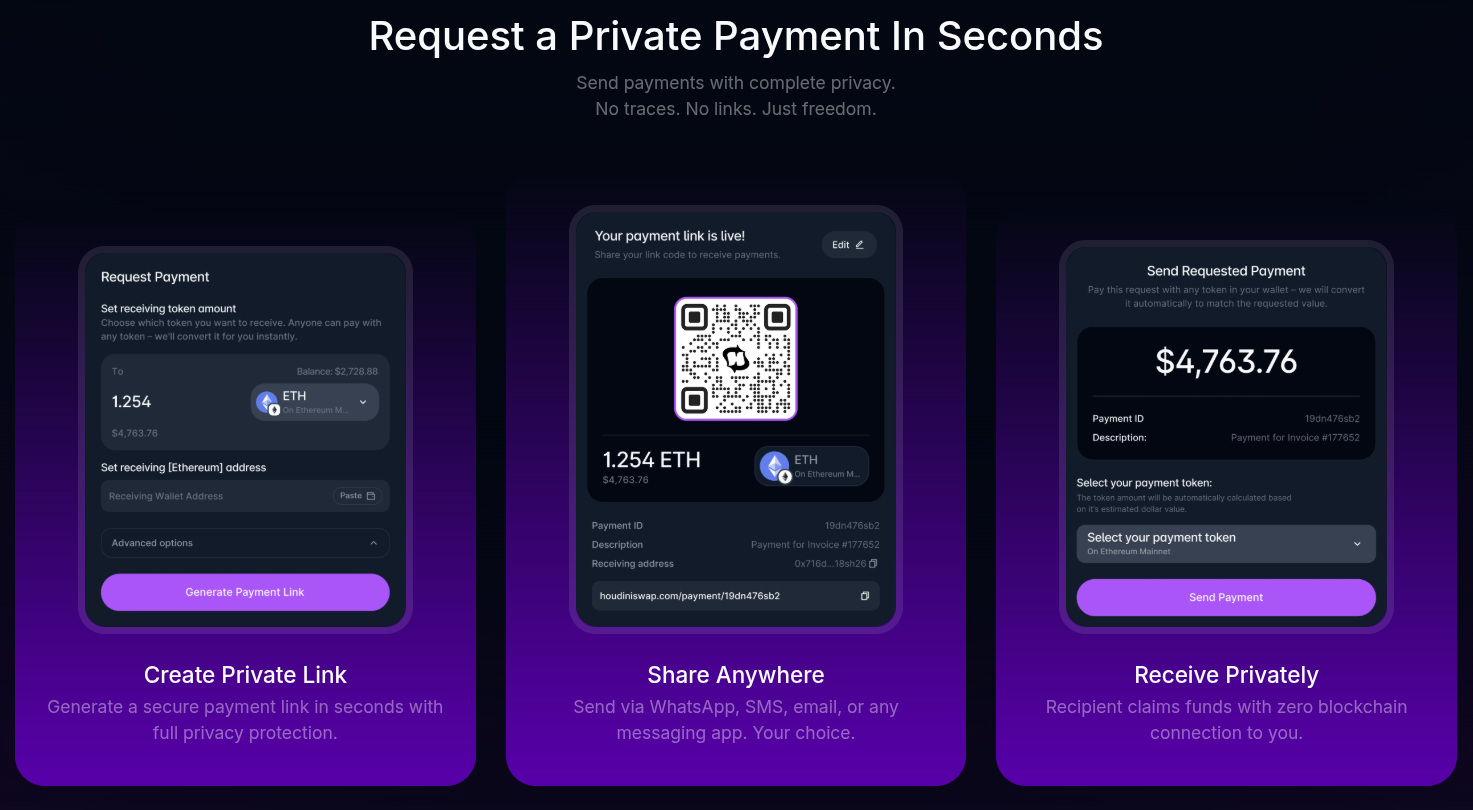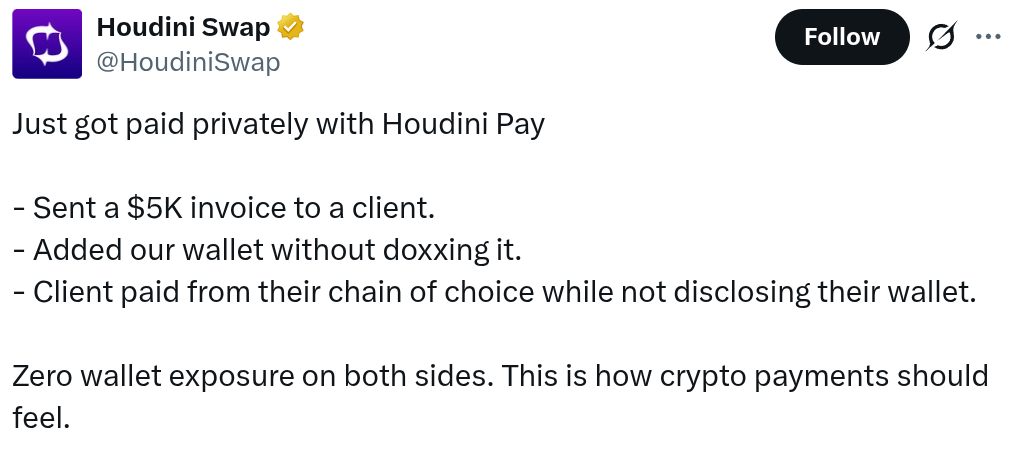Houdini Pay is a new private payment service from Houdini Swap that enables users to receive cryptocurrency payments in their chosen asset without exposing onchain addresses, enhancing surface-level privacy by breaking links between sender and receiver wallets.
-
Houdini Pay supports over 4,000 digital assets across multiple blockchains, allowing seamless conversions.
-
Users generate shareable payment links that route transactions through a centralized aggregator to obscure wallet connections.
-
The service complies with AML regulations while providing basic privacy protections, with fees covered by senders ensuring recipients get the full amount.
Discover Houdini Pay, the innovative crypto payment solution from Houdini Swap offering privacy without onchain exposure. Learn how it supports 4,000+ assets and breaks payment links for secure transactions. Explore now for enhanced financial privacy.
What is Houdini Pay?
Houdini Pay is a centralized payment service launched by the instant exchange aggregator Houdini Swap, designed to provide users with a layer of privacy in cryptocurrency transactions. It allows recipients to generate shareable payment links for payments in their preferred digital asset, automatically converting incoming funds without revealing the recipient’s onchain address to the sender. This setup ensures that the onchain connection between counterparties is severed, preventing either party from tracking the other’s wallet activities directly.
How does Houdini Pay ensure privacy in crypto payments?
Houdini Pay achieves privacy by routing payments through Houdini Swap’s backend infrastructure, where the sender’s asset is swapped and delivered to the recipient’s wallet without an explicit onchain link. Supporting more than 4,000 tokens across various blockchains, the service uses a centralized model that complies with Anti-Money Laundering (AML) standards, including geoblocking and metadata retention for involved wallets, assets, amounts, and IP addresses. According to documentation from Houdini Swap, if a transaction raises flags, additional verification may be required under AML policies, balancing privacy with regulatory adherence.
While this breaks visible onchain trails, it does not offer cryptographic guarantees like zero-knowledge proofs. Houdini Swap CEO Joshua Rogers has clarified that the platform acts as a compliant privacy tool, stating, “Houdini Pay is a compliant privacy infrastructure that does never hold, custody, or access user crypto.” For users seeking stronger anonymity, alternatives like zkBob employ shielded pools to hide sender, receiver, and amount details onchain, though limited to assets such as Ether (ETH), USD Tether (USDT), and USD Coin (USDC). Experts in blockchain privacy, including those from established protocols, emphasize that such centralized approaches provide practical utility for everyday payments but fall short of decentralized, trustless privacy solutions.
The service’s fees mirror those of the underlying Houdini Swap aggregator and are borne by the sender, ensuring the recipient receives the exact requested amount. Payment links remain active indefinitely but are fixed in value and non-editable, making them suitable for specific, recurring payment scenarios.

Houdini Pay UI explanation. Source: HoudiniSwap
Frequently Asked Questions
What assets and blockchains does Houdini Pay support?
Houdini Pay accommodates over 4,000 digital assets spanning multiple blockchains, enabling users to receive payments in their preferred token through automated swaps via the Houdini Swap platform. This broad compatibility makes it versatile for various cryptocurrency holders seeking privacy-focused transfers without manual interventions.
Is Houdini Pay suitable for users prioritizing maximum privacy?
For basic privacy needs like hiding wallet details from counterparties, Houdini Pay works well by breaking onchain links in a compliant manner. However, for advanced anonymity, consider zero-knowledge-based services that offer onchain obfuscation, as Houdini Pay retains metadata and adheres to AML checks without cryptographic hiding of transaction details.
Key Takeaways
- Enhanced Payment Privacy: Houdini Pay severs onchain connections between senders and receivers, protecting wallet balances and histories from mutual exposure in business or personal transactions.
- Broad Asset Support: With compatibility for over 4,000 tokens across chains, it facilitates seamless conversions, though centralized compliance means metadata is logged for regulatory purposes.
- Practical Applications: Ideal for freelancers avoiding rate undercutting or users mitigating physical risks from visible holdings, but pair with stronger tools for full anonymity.
The rise in cryptocurrency adoption has highlighted the need for privacy tools like Houdini Pay, which addresses key vulnerabilities in public blockchains by obscuring payment trails in a regulated framework. As crypto privacy payment services evolve, innovations from platforms such as Houdini Swap demonstrate how centralized solutions can bridge usability and security gaps. Looking ahead, integrating more advanced privacy features could further empower users in an increasingly transparent digital economy—start exploring compliant options today to safeguard your financial interactions.
Centralized instant exchange aggregator Houdini Swap has introduced Houdini Pay, a service focused on providing surface-level privacy by disconnecting onchain links between transaction parties. This allows recipients to get payments in their desired cryptocurrency without disclosing their wallet address, a step forward in practical crypto usability.
According to an announcement shared with Cointelegraph, the platform enables the creation of shareable payment links compatible with thousands of assets. Funds are swapped to the recipient’s choice, and the intermediary process ensures no direct onchain tie between sender and receiver, safeguarding against unwanted wallet surveillance.
Service costs, derived from the Houdini Swap exchange, are handled by the sender, delivering the complete amount to the recipient. Links persist without expiration but lock in a specific payment value, suiting predefined transactions over flexible ones.
Though effective for link-breaking, Houdini Pay’s centralized nature includes AML compliance and data retention practices. Transaction details like wallet addresses and IPs are stored, with potential for further inquiries on suspicious activities. This setup prioritizes regulatory alignment over absolute anonymity.
Houdini Swap CEO Joshua Rogers distinguishes it from mixers, noting it as infrastructure that avoids custody of funds. For deeper privacy, zero-knowledge services provide verifiable hiding, albeit with narrower asset support.
Privacy remains crucial in crypto for commercial and personal safety. Public addresses expose balances, histories, and interactions, enabling issues like competitive espionage or targeted attacks. Rogers highlights real-world harms, such as freelancers facing slashed rates after wallet checks.
Recent incidents, including $5 wrench attacks and violent crimes against holders, underscore these risks. In May, French authorities engaged crypto experts following a kidnapping attempt on an exchange executive’s family, signaling growing concerns over visible wealth in the sector.

Source: HoudiniSwap
Conclusion
In summary, Houdini Pay from Houdini Swap offers a compliant gateway to crypto privacy payment services, enabling secure, link-free transactions across a vast asset ecosystem. By addressing onchain transparency’s pitfalls, it supports safer adoption in business and daily use. As privacy demands intensify amid rising threats, staying informed on such developments will be key to navigating the blockchain landscape effectively.
